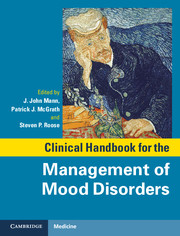Book contents
- Clinical Handbook for the Management of Mood Disorders
- Clinical Handbook for the Management of Mood Disorders
- Copyright page
- Contents
- List of contributors
- Section 1 Introduction
- Section 2 Medical management
- Section 3 Psychotherapies for mood disorders
- Section 4 Specific modalities of treatment
- 24 Electroconvulsive therapy
- 25 Transcranial magnetic stimulation and deep brain stimulation
- 26 Chronotherapeutics
- 27 Ketamine in treatment-resistant depression
- Section 5 The promise of biomarkers and response prediction
- Section 6 Future directions
- Index
27 - Ketamine in treatment-resistant depression
from Section 4 - Specific modalities of treatment
Published online by Cambridge University Press: 05 May 2013
- Clinical Handbook for the Management of Mood Disorders
- Clinical Handbook for the Management of Mood Disorders
- Copyright page
- Contents
- List of contributors
- Section 1 Introduction
- Section 2 Medical management
- Section 3 Psychotherapies for mood disorders
- Section 4 Specific modalities of treatment
- 24 Electroconvulsive therapy
- 25 Transcranial magnetic stimulation and deep brain stimulation
- 26 Chronotherapeutics
- 27 Ketamine in treatment-resistant depression
- Section 5 The promise of biomarkers and response prediction
- Section 6 Future directions
- Index
Summary
Keywords
- Type
- Chapter
- Information
- Clinical Handbook for the Management of Mood Disorders , pp. 345 - 357Publisher: Cambridge University PressPrint publication year: 2013
- 1
- Cited by

